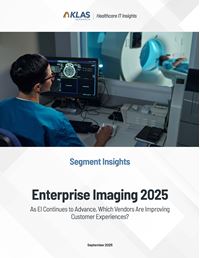 2025 BEST IN KLAS
2025 BEST IN KLAS
Preferences
Related Series
Related Segments


Enterprise Imaging 2019
Strategic Contributors to Progress
Enterprise imaging strategies aim to align provider departments, priorities, and technologies to drive key outcomes. KLAS has watched some strategies evolve and grow while others struggle to take shape. The purpose of this report is to (1) provide an update on industry progress, (2) show how both healthcare provider organizations and vendors contribute to that progress, and (3) identify which enterprise imaging vendors act as true strategic partners that drive success.
What Is Enterprise Imaging?
KLAS defines enterprise imaging as the ability to store and/or view images across the enterprise from more than one service line or storage solution.
Of 113 Organizations Doing Enterprise Imaging, Two-Thirds Have Seen Progress Since 2018
The addition of service lines to VNAs and universal viewers is becoming more deliberate, with a focus on workflows, adoption, and image access for patients and referring physicians. A significant gain in enterprise imaging is the addition of more sites (e.g., hospitals and image centers) to provider organizations’ enterprise imaging technologies. Advanced organizations are stabilizing and evaluating future technology needs. Funding gaps, provider organization consolidation, poor internal alignment, and weak vendor partners have contributed to one-fifth of organizations finding their strategic progress either stalled or regressing.

Internal Strategy Makes or Breaks Success; Vendors Are Playing A Strategic Role
Organizations whose progress has stalled or regressed rate their own strategic contribution significantly lower than their vendors’. Poor communication, executive buy-in, IT support, and vision hinder success, regardless of vendor partners. Vendors are still critical players, providing strategy (best practices and imaging expertise) and technology. Technology contributions from vendors are growing, with 89% of organizations (up from 55% in 2018) using both a VNA and a universal viewer (as opposed to one or the other).

Access to Relevant Images Is the Most Frequently Reported Outcome
Reported access to relevant images through both the VNA and universal viewer is up nearly 20% from 2018, with the most progress on the universal viewer side (primarily being used referentially). This shift is improving clinician productivity. In all other areas, outcomes reporting has improved slightly. EMR integration is considered a key vehicle to driving outcomes in the areas shown below. Where this is achieved, provider organizations’ satisfaction and perceived value from their enterprise imaging strategy increases.

Enterprise Imaging Strategies More Mature Than Ever
KLAS’ 2018 enterprise imaging study identified four structural pieces in place at organizations with a mature enterprise imaging strategy: organizational IT support and funding, the ability to electronically ingest images, a fully deployed encounter-based imaging strategy, and strong governance. In that study, one-third of organizations were structurally immature. Today, that number has dropped to one-fifth due to better governance and more funding and support at the organization level. Though strategy is mature, market adoption and depth still have room to grow.

Watson Health Imaging Holding Steady; Agfa HealthCare’s Strategic Position Improving; Hyland Stagnates
Watson Health Imaging is a historical market leader with an advanced enterprise imaging customer base who enjoyed strong partnership. Since the IBM acquisition, customers report that less engaged support, lack of development, and poor road map visibility prevent them from rapidly advancing the next stage in their enterprise imaging journey. Agfa HealthCare has a large legacy-solution footprint with some adoption of their new Enterprise Imaging platform.

Agfa Enterprise Imaging customers say that Agfa has refreshed their enterprise imaging vision and supports customers through a consultative approach to strategy. These early adopters of Agfa’s new platform feel it is an improvement over IMPAX. Customers want Agfa to continue progressing by improving ongoing communication and go-lives. Both Watson and Agfa are highly considered and proven to scale. Hyland customers feel their vendor’s strategic contribution has stalled, and frustrations with the lack of strategic advisement have persisted since the acquisition of Lexmark. Despite this, Hyland customers are realizing outcomes, though they are largely limited to radiology and cardiology. Philips (Carestream) customers tend to have less adoption outside radiology; overall, they are highly satisfied with their vendor.
Lack of Effective Operational Guidance Frustrates GE Healthcare and Fujifilm Customers
Though GE Healthcare is the most improved vendor for their universal viewer since 2018 thanks to product updates, they are still seen by their large customer base as the least strategic enterprise imaging vendor, receiving below-average marks for operational influence due to a lack of delivery outside radiology. This gap hampers GE Healthcare’s ability to help provide needed best practices and strategic planning. Ineffective support and nickel-and-diming further impact customers’ perceptions of the vendor.
While Fujifilm scores well in general VNA performance†, they are similarly described as lacking strategic collaboration, and integration challenges keep many customers from success even when they are using the full Fujifilm imaging suite. Part of the challenge is the siloed nature of Fuji’s support groups; customers describe being shuffled around when asking for help with multiple pieces of technology. While less frequent, success with Fuji is possible when the customer has strong internal alignment and is vocal about receiving upgrades, getting bugs resolved, and receiving the regular support and touches they need.
† Includes enterprise imaging and non-enterprise imaging customers

Agfa Customers Have Consistently High Outcomes; Fujifilm Struggles to Deliver
Agfa is described as scalable across service lines and capable of handling large volumes and image types. Collaboration and improved patient care are supported through strong integration between Agfa’s zero-footprint viewer and customers’ EMRs. To realize these outcomes, prospective customers should be prepared to put in the work to set up the storage structure and workflows. Many Fuji customers struggle to move beyond using the VNA for disaster recovery and take advantage of more strategic outcomes because of a lack of strategic guidance from Fuji. GE Healthcare VNA customers do achieve outcomes, but those outcomes are inconsistent across service lines. On the universal viewer side, functionality issues and significant upgrade challenges limit GE Healthcare’s value.

Adoption across Service Lines Increases for Most Vendors, but GE Healthcare and Philips (Carestream) Slower to Expand
Technology and strategy struggles prevent GE Healthcare customers from making expected progress, though most still hope to expand. Philips (Carestream) customers tend to be less structurally mature and have low adoption outside of radiology and cardiology. Because of this focused adoption, customers can focus on realizing outcomes over expanding. Fewer Philips (Carestream) customers have plans to expand to other service lines, and the full impact of the recent acquisition of Carestream by Philips is unknown. Across the industry, adoption of additional service lines is growing; all vendors in this report have been validated as expanding outside of the mainstays of enterprise imaging to areas such as OR, ophthalmology, and OB/GYN. Around one-third of organizations have expanded to include additional service lines and data sources (e.g., ambulatory sites, additional PACS deployments).

Bottom Lines on Other Validated Enterprise Imaging Vendors
KLAS has validated organizations using several other vendors for enterprise imaging. Adoption of these solutions is limited.


Writer
Emily Paxman

Designer
Natalie Jamison

Project Manager
Robert Ellis
This material is copyrighted. Any organization gaining unauthorized access to this report will be liable to compensate KLAS for the full retail price. Please see the KLAS DATA USE POLICY for information regarding use of this report. © 2025 KLAS Research, LLC. All Rights Reserved. NOTE: Performance scores may change significantly when including newly interviewed provider organizations, especially when added to a smaller sample size like in emerging markets with a small number of live clients. The findings presented are not meant to be conclusive data for an entire client base.












